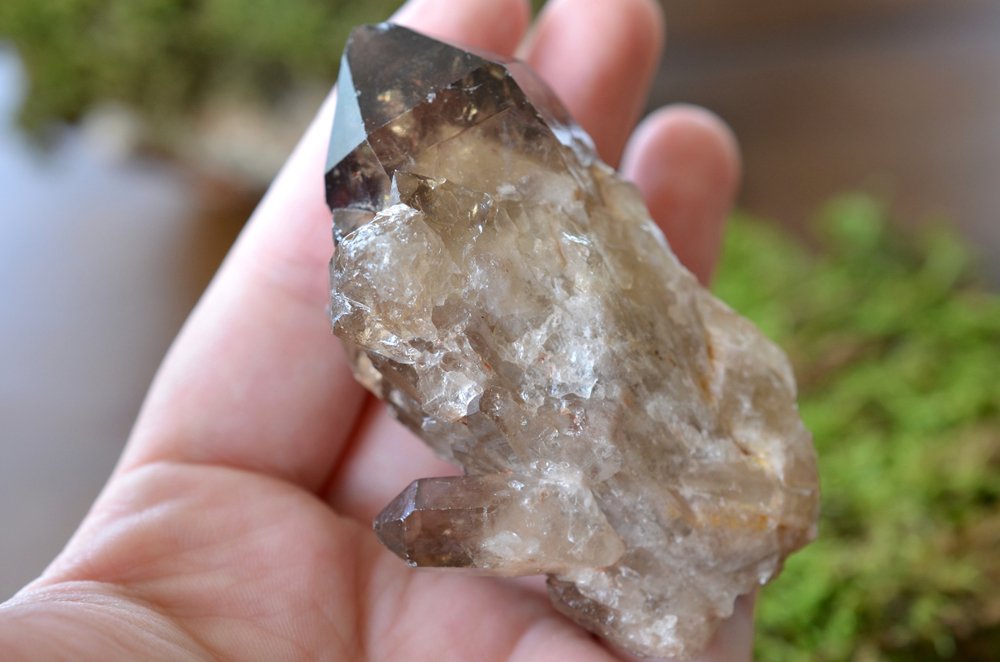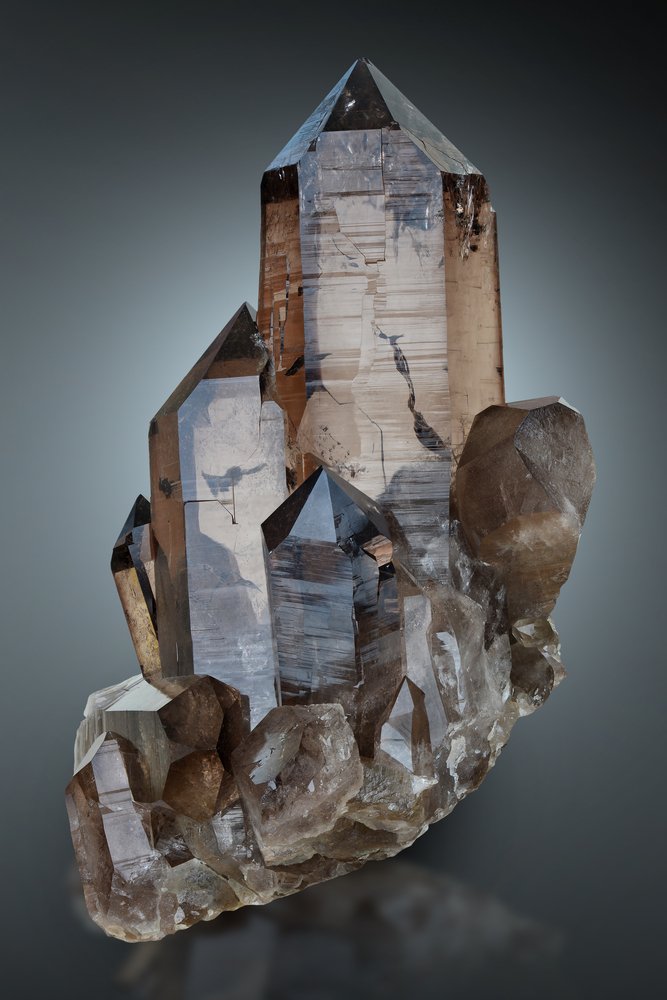In addition to the beauty of natural resources, many of us also appreciate the knowledge that the Earth itself produced the treasure. This can be quite hard in some cases, since not every fake is “fake” in the sense that we normally use the word. Smoky quartz is one of those crystals that everyone loves, which means there are a lot of fakes out there.
So, if you want to learn how to tell if your smokey quartz is real then read on, and I’ll help you do your best to determine the veracity of your crystals in your own home,
Defining Real Smokey Quartz
We need to define some things before we can really dig into the heart of the matter and do a bit of a reality check.
Synthetic quartz with trace element doping is a thing. It’s not easy to do, but it’s a well-understood process that’s been done on a massive scale.
Synthetic Crystals
Synthetic crystals are grown. When you see a synthetic emerald somewhere, it’s really a lab-grown beryl crystal doped with chromium. The only difference is in very small details that aren’t readily apparent to the eye. Indeed, one of the “tells” for a synthetic emerald is that they lack inclusions to the same level that natural emeralds display.
Synthetic material can be bought and sold ethically, but it requires disclosure. If I’m unsure of the origin of a precious gem, such as aquamarine or ruby, I will often label it as synthetic since that’s generally the case when you lack a paperwork trail.
Quartz isn’t followed to the same extent as you’ll find people tracking things like sapphire or rubies. It’s not as valuable in small amounts, so maintaining some of the information you’ll need to be 100% sure often doesn’t happen.
I have around fifteen specimens of it myself, only one of which I know the provenance of.
Simulant Materials
Simulant material is “true” faked material. Simulants are used in place of natural material, generally with the intent to deceive. It can be a simple bait-and-switch, with glass being the most common material used, or it can be a material made specifically to deceive.
You’ll find both of these when looking at smokey quartz (especially cut) but the latter is what most people are concerned about.

Detecting Simulant Material
Simulant material is usually very easy to detect if it’s in hand. Take a knife that’s known to be good steel. Try to scratch the material. Even the best steel is under a 7.0 on the Moh’s scale and won’t let you gouge a specimen of quartz. Most glass will scratch, given a bit of effort.
I haven’t seen any fakes made from it yet, but there’s a series of colors released by the maker of Nanosital that mimic it. You’re unlikely to be able to tell the difference at first glance, but it does have a higher specific gravity.
The world of gemstones and crystals is very complex. Silica is everywhere, for instance, and while the crystallized form is quartz, the amorphous form created by melting and relatively fast cooling is just glass.
If you think you have a simulant on hand, you want to check and see if it lines up with quartz.
- Hardness of 7.0- Quartz is the defining mineral for a 7.0 on the Moh’s scale. If it’s harder or softer than a 7.0 you have something different on hand. Most simulants are just glass and will sit around a 5-5.5.
- Specific Gravity at 2.65- Specific gravity tests aren’t the most fun thing in the world, but they’re one of the best ways to detect simulant material. Most non-glass fakes will be significantly higher or lower than 2.65.
- Refractive Index of 1.54-1.55- RI is harder to test than the other two qualities. A basic video on the use is necessary. It’s a very good tell, but they’re kind of a pain and if the other two qualities match then I’ll be trying to determine if it’s a synthetic smokey quartz instead of a natural one.
Here’s the real issue: few people are going to spend the necessary time on the specimen. I’ve tested SG for other people’s quartz samples, but I generally don’t bother with too much testing for the quartz family in general.
There’s a reason for that: literal tons of low-grade quartz are irradiated, giving them a smokey color, and then sold without disclosing the practice.
So, Is This Synthetic Smoky Quartz?
The issue of synthetic quartz comes up a lot when people talk about it. That goes for all varieties, from amethyst to citrine to our lovely dark smokey quartz. Clear quartz is incredibly unlikely to be synthetic, there’s a high-demand for optical-quality quartz that consumes most of the market.
My official stance on most colored quartz is that you’ll never know for sure. Not unless you pulled it from the ground yourself. I’m not a gemologist or crystallographer, but the general perception is that a well-done fake may, in fact, just be undetectable.

What About Irradiated Natural Quartz?
The biggest problem we run into is that smokey quartz doesn’t have a very unique chemical composition. The reaction comes from aluminum trapped in the crystal lattice. Add a bit of radiation, and you now have smokey quartz.
Well, it’s more complicated than that. If you’re up on your crystallography, check this paper which is entirely about the formation of different colored quartz and discusses the radiation banding and subsequent changes.
So a carefully created synthetic smokey quartz, properly analyzed with lab equipment, may not be distinguishable from a natural one.
But it’s not worth the effort, time, or energy costs to carefully create smokey quartz from natural quartz. So what we often see instead is low-grade quartz, generally from Arkansas. It’s subsequently been “touched up” by someone with access to a method of irradiation. Since they probably don’t care much and just want to sell their crystals for a few extra bucks, they tend to do it in bulk and without much care.
I can recognize one of these by sight, and I think a lot of collectors can.
The crystals themselves are almost always a dark brown to black color, with odd color zoning, including a white base when they’re seen as points or clusters. They generally have heavy inclusions and internal flaws.
In general, s smokey quartz that is dark through the entire crystal is likely to be real.
If your smokey is a cut gemstone… I say you should just enjoy it because you’ll probably never know. It’s only errors made in the process that give us hints. As is the case with heat-treated amethyst that’s turned into citrine, I’d just enjoy it.
The reason why these crystals look so similar is easy: they’re formed the exact same way. The coloration of material like smokey quartz generally occurs after crystal growth, so it’s just a matter of when it happened.
Some people are open about the treatment, but the majority aren’t. I’d suggest looking them up online, they’re generally sold as “treated smokey quartz” rather than “irradiated smokey quartz” since the latter tends to make people a bit more nervous.
This can help you identify whether or not your smokey was irradiated in the ground. The only rational way I’ve heard to detect them involves tracing the miniscule physical damage radiation causes to the crystals.
There is one more way that you can find out, but most people don’t have the information.
Provenance is the Best Way to Know
Where the stone came from is the best way to know if you have an artificially irradiated sample or not. I wouldn’t rely on overseas dealers to give you this information.
The key is to not just take their word for it, but to look up what other samples from the area look like. Many spots have some tell-tale signs. If you can’t find anything on mindat’s database then look for rock groups on Facebook local to that region. There’s something for pretty much everywhere, at least at the regional level.
And you can find a rockhound that’s actually gone out there and pulled something from the earth in that area.
Yes, it’ll make for more expensive specimens most of the time. When I glanced through a couple of well-known retail sites I could see more obvious examples of the Arkansas material I described above than I did crystals that looked natural.
But in the end, the only way to know for sure if you have a naturally irradiated crystal is to pull one from the ground yourself. My personal recommendation is always going to involve a rock pick and an adventure.
- Online rock and mineral club for collectors of all levels!
- Find community with like-minded rock and mineral enthusiasts.
- Monthly Giveaways!
- Free Access to Entire Digital Library of Products (current and future products)*


